INSTITUT SUPERIEUR D'ANTHROPOLOGIE
INSTITUT OF ANTHROPOLOGY
COURS ONLINE – COURS A DISTANCE
INSCRIPTIONS : SEPTEMBRE 2024
REGISTER NOW
ANGLETERRE – 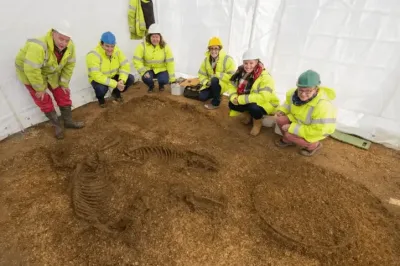 Pocklington - Simon Usher, managing director at Persimmon Homes Yorkshire, reported: “We can confirm that a significant archaeological discovery, featuring an Iron Age horse-drawn chariot, has been made at our development, The Mile in Pocklington. Careful excavation is ongoing by our archaeologists and a thorough investigation is in process to date and detail the find.” This isn’t the first time that a buried chariot has appeared in this region of England. In 2017, a different chariot was found along with the horses attached to it. This latest find, however, had the rider included. Archaeology Arts reported in 2017: “The chariot was buried as part of a funerary practice that was not uncommon in the Iron Age. However, the horses were a rather surprising addition.”
Pocklington - Simon Usher, managing director at Persimmon Homes Yorkshire, reported: “We can confirm that a significant archaeological discovery, featuring an Iron Age horse-drawn chariot, has been made at our development, The Mile in Pocklington. Careful excavation is ongoing by our archaeologists and a thorough investigation is in process to date and detail the find.” This isn’t the first time that a buried chariot has appeared in this region of England. In 2017, a different chariot was found along with the horses attached to it. This latest find, however, had the rider included. Archaeology Arts reported in 2017: “The chariot was buried as part of a funerary practice that was not uncommon in the Iron Age. However, the horses were a rather surprising addition.”
Iron Age Chariot With Horse And Driver In Tow Was Discovered In England (allthatsinteresting.com)
Rep. TCHEQUE – 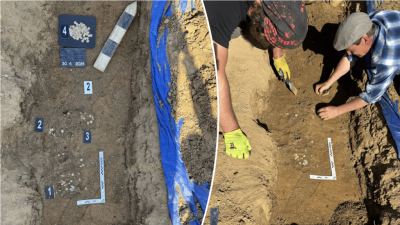 - Kutná Hora - A woman walking in the town of Kutná Hora in the Central Bohemian Region of the Czech Republic found a nearly 900-year-old treasure of more than 2,150 medieval silver coins, known as denarii. The treasure consisted of more than 2,150 silver coins minted between 1085 and 1107. Experts believe they were manufactured in Prague and imported to Bohemia. The trove was stored in a ceramic container that was destroyed over the years, but archaeologists discovered the bottom of the container. “The [discovery was] made of coin alloy, which, in addition to silver, also contains an admixture of copper, lead, and trace metals,” the Institute of Archaeology of the Czech Academy of Sciences (ARUP) stated in the press release. “Determining this particular composition can also help determine the origin of the silver used.”
- Kutná Hora - A woman walking in the town of Kutná Hora in the Central Bohemian Region of the Czech Republic found a nearly 900-year-old treasure of more than 2,150 medieval silver coins, known as denarii. The treasure consisted of more than 2,150 silver coins minted between 1085 and 1107. Experts believe they were manufactured in Prague and imported to Bohemia. The trove was stored in a ceramic container that was destroyed over the years, but archaeologists discovered the bottom of the container. “The [discovery was] made of coin alloy, which, in addition to silver, also contains an admixture of copper, lead, and trace metals,” the Institute of Archaeology of the Czech Academy of Sciences (ARUP) stated in the press release. “Determining this particular composition can also help determine the origin of the silver used.”
A woman in the Czech Republic found a medieval jackpot during a walk - Arkeonews
USA – 
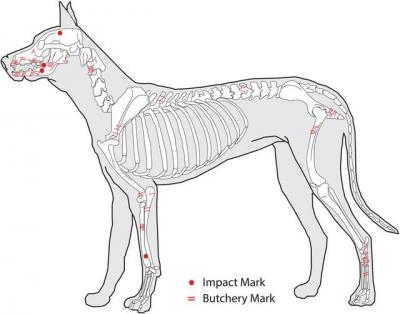 Jamestown - The first English settlers to arrive in North America ate indigenous dogs to survive an extreme period of starvation, according to a new study. A famine at Jamestown may have resulted from the consumption of dogs with Indigenous ancestry, according to new research that challenges previous historical narratives and reveals intricate relationships between early European colonists and Indigenous communities. Researchers at the University of Iowa discovered that six dogs from the Virginia Company Period in Jamestown—the first permanent English settlement in North America—possessed Indigenous ancestry and were eaten by the settlers. In the study, scientists analyzed genetic material from archaeological specimens of dogs that lived in Jamestown between 1609 and 1617 AD. At least six of the Jamestown dogs that were analyzed had unambiguous evidence of Native American ancestry. These dogs shared mitogenomic similarities with Hopewellian, Mississippian, and Late Woodland period dogs from eastern North America. The researchers also found that the six dogs were consumed by the residents at Jamestown. These results indicate the existence of intricate factors that contributed to the dogs’ existence in the Fort and the consumption of Indigenous dogs by Jamestown’s residents before, during, and following the Starving Time. Archaeologists said the practice was not uncommon at the time.
Jamestown - The first English settlers to arrive in North America ate indigenous dogs to survive an extreme period of starvation, according to a new study. A famine at Jamestown may have resulted from the consumption of dogs with Indigenous ancestry, according to new research that challenges previous historical narratives and reveals intricate relationships between early European colonists and Indigenous communities. Researchers at the University of Iowa discovered that six dogs from the Virginia Company Period in Jamestown—the first permanent English settlement in North America—possessed Indigenous ancestry and were eaten by the settlers. In the study, scientists analyzed genetic material from archaeological specimens of dogs that lived in Jamestown between 1609 and 1617 AD. At least six of the Jamestown dogs that were analyzed had unambiguous evidence of Native American ancestry. These dogs shared mitogenomic similarities with Hopewellian, Mississippian, and Late Woodland period dogs from eastern North America. The researchers also found that the six dogs were consumed by the residents at Jamestown. These results indicate the existence of intricate factors that contributed to the dogs’ existence in the Fort and the consumption of Indigenous dogs by Jamestown’s residents before, during, and following the Starving Time. Archaeologists said the practice was not uncommon at the time.
New Study Reveals That the First English Settlers in North America Ate Dogs to Survive - Arkeonews
MEXIQUE – 
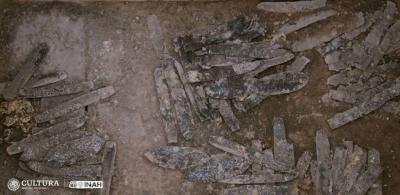 Tlatelolco - Archaeologists from the National Institute of Anthropology and History (INAH) have unearthed a very special votive offering during excavations at Temple “I,” also known as the Great Basement, within the Tlatelolco archaeological zone in present-day Mexico City. The offering, which was found inside a stone box or cist, contains copal blocks and a sizable assortment of different types of obsidian knives. The finding provides invaluable insights into the ceremonial practices of the Tlatelolca people between 1375 and 1418 AD. Archaeologists Francisco Javier Laue Padilla and Paola Silva Álvarez discovered the offering while investigating a crack near the central altar of the Great Basement. The find consists of a stone box containing ceremonial offerings placed between CE 1375 and 1418 to consecrate an architectural expansion of Temple “I”, also known as the Great Basement. Archaeologists discovered 59 pocket knives, 7 obsidian knives, and copal blocks inside the stone box. These objects were used by Tlatelolca priests and high-ranking officials for self-sacrifice. In the INAH announcement, Salvador Guilliem Arroyo, the project director, emphasized the significance of the Great Basement, believed to be analogous to the House of the Tenochca Eagles of Tenochtitlan, and dedicated to Tezcatlipoca, the “lord of the smoking obsidian mirror”, a major, if not the primary Aztec god. Every component in the offering box has great symbolic significance and may be connected to gods like Tezcatlipoca. The thorough examination of these artifacts will deepen our comprehension of the Tlatelolca people’s ceremonial customs and the immensely rich and varied Mesoamerican pantheon.
Tlatelolco - Archaeologists from the National Institute of Anthropology and History (INAH) have unearthed a very special votive offering during excavations at Temple “I,” also known as the Great Basement, within the Tlatelolco archaeological zone in present-day Mexico City. The offering, which was found inside a stone box or cist, contains copal blocks and a sizable assortment of different types of obsidian knives. The finding provides invaluable insights into the ceremonial practices of the Tlatelolca people between 1375 and 1418 AD. Archaeologists Francisco Javier Laue Padilla and Paola Silva Álvarez discovered the offering while investigating a crack near the central altar of the Great Basement. The find consists of a stone box containing ceremonial offerings placed between CE 1375 and 1418 to consecrate an architectural expansion of Temple “I”, also known as the Great Basement. Archaeologists discovered 59 pocket knives, 7 obsidian knives, and copal blocks inside the stone box. These objects were used by Tlatelolca priests and high-ranking officials for self-sacrifice. In the INAH announcement, Salvador Guilliem Arroyo, the project director, emphasized the significance of the Great Basement, believed to be analogous to the House of the Tenochca Eagles of Tenochtitlan, and dedicated to Tezcatlipoca, the “lord of the smoking obsidian mirror”, a major, if not the primary Aztec god. Every component in the offering box has great symbolic significance and may be connected to gods like Tezcatlipoca. The thorough examination of these artifacts will deepen our comprehension of the Tlatelolca people’s ceremonial customs and the immensely rich and varied Mesoamerican pantheon.
Rare Ceremonial Knives Offering Discovered in the Great Basement of Tlatelolco, Mexico - Arkeonews
CHINE –  Liujiang - Chinese researchers have provided new age estimates and revised provenience information for the Liujiang human fossils, which represent one of the most complete fossil skeletons of Homo sapiens in China, according to a recent research article published in Nature Communications. This was reported by The Xinhua News Agency. The emergence of Homo sapiens in Eastern Asia is a topic of significant research interest, while well-preserved human fossils in secure, dateable contexts in this region are extremely rare. Tongtianyan cave in Liuzhou City, south China's Guangxi Zhuang Autonomous Region, is one of the most important fossils finds of H. sapiens, though its age has been debated, with chronometric dates ranging from the late Middle Pleistocene to the early late Pleistocene. Through the four-year comprehensive stratigraphic and chronological studies, the researchers from the Institute of Vertebrate Paleontology and Paleoanthropology of the Chinese Academy of Sciences (CAS), the Nanjing Normal University and the CAS Institute of Geology and Geophysics have solved a 66-year chronological mystery and dated the Liujiang H. sapiens to between 33,000 and 23,000 years ago. The revised age estimates correspond with the dates of other human fossils in northern China, including Tianyuan Cave and Zhoukoudian Upper Cave, indicating the geographically widespread presence of H. sapiens across Eastern Asia in the late Pleistocene. The comprehensive study is significant for integrating the Liujiang human fossils into the early modern human evolutionary sequence and better understanding human dispersals and adaptations in the region.
Liujiang - Chinese researchers have provided new age estimates and revised provenience information for the Liujiang human fossils, which represent one of the most complete fossil skeletons of Homo sapiens in China, according to a recent research article published in Nature Communications. This was reported by The Xinhua News Agency. The emergence of Homo sapiens in Eastern Asia is a topic of significant research interest, while well-preserved human fossils in secure, dateable contexts in this region are extremely rare. Tongtianyan cave in Liuzhou City, south China's Guangxi Zhuang Autonomous Region, is one of the most important fossils finds of H. sapiens, though its age has been debated, with chronometric dates ranging from the late Middle Pleistocene to the early late Pleistocene. Through the four-year comprehensive stratigraphic and chronological studies, the researchers from the Institute of Vertebrate Paleontology and Paleoanthropology of the Chinese Academy of Sciences (CAS), the Nanjing Normal University and the CAS Institute of Geology and Geophysics have solved a 66-year chronological mystery and dated the Liujiang H. sapiens to between 33,000 and 23,000 years ago. The revised age estimates correspond with the dates of other human fossils in northern China, including Tianyuan Cave and Zhoukoudian Upper Cave, indicating the geographically widespread presence of H. sapiens across Eastern Asia in the late Pleistocene. The comprehensive study is significant for integrating the Liujiang human fossils into the early modern human evolutionary sequence and better understanding human dispersals and adaptations in the region.
Researchers date living age of Liujiang Homo sapiens in south China | Ukrainian news (ukranews.com)
CANADA –  Calgary - Beside a gravel footpath that winds along the top of a hill on the east side of Nose Hill Park in Calgary, lies a circle of stones. Until recently, only parts of the circle were visible to passersby, many of whom unknowingly walked straight through a site that is now the subject of an archaeological excavation aimed at uncovering more about the life of the Blackfoot people. The University of Calgary's archaeology field school and public archaeology program, in partnership with Calgary Parks and Open Spaces, broke ground on the project on May 13. The stone circle itself is a remnant of a Blackfoot camp, a place where a lodge would have once been erected. By comparison, a stone circle, while not always offering the same quantity of artifacts, can provide insight into what individuals were doing on a regular basis. So far, the dig has been fruitful. Pieces of stone tools, and even shells have been discovered, which Amundsen-Meyer says were used to make beads and other decorative objects. While the date of the site is unknown at this point, it is likely from the pre-contact period, said Amundsen-Meyer. She suspects it would have been part of a seasonal camp for the Blackfoot people in the warmer months, given the area's exposure. According to a 2019 report by the City of Calgary, evidence from a nearby excavation carried out in the late 1970s in an area called the Hawkwood site showed that people hunted and cooked bison on Nose Hill. "Based on the tried and tested combination of radiocarbon dates and the distinctive shapes of stone artifacts used to tip spears, darts, and arrows, we know people used the area of the Hawkwood site many times," reads the report. Remains from the Hawkwood site have been dated as far back as 8,250 years ago, and as recent as 500 years ago.
Calgary - Beside a gravel footpath that winds along the top of a hill on the east side of Nose Hill Park in Calgary, lies a circle of stones. Until recently, only parts of the circle were visible to passersby, many of whom unknowingly walked straight through a site that is now the subject of an archaeological excavation aimed at uncovering more about the life of the Blackfoot people. The University of Calgary's archaeology field school and public archaeology program, in partnership with Calgary Parks and Open Spaces, broke ground on the project on May 13. The stone circle itself is a remnant of a Blackfoot camp, a place where a lodge would have once been erected. By comparison, a stone circle, while not always offering the same quantity of artifacts, can provide insight into what individuals were doing on a regular basis. So far, the dig has been fruitful. Pieces of stone tools, and even shells have been discovered, which Amundsen-Meyer says were used to make beads and other decorative objects. While the date of the site is unknown at this point, it is likely from the pre-contact period, said Amundsen-Meyer. She suspects it would have been part of a seasonal camp for the Blackfoot people in the warmer months, given the area's exposure. According to a 2019 report by the City of Calgary, evidence from a nearby excavation carried out in the late 1970s in an area called the Hawkwood site showed that people hunted and cooked bison on Nose Hill. "Based on the tried and tested combination of radiocarbon dates and the distinctive shapes of stone artifacts used to tip spears, darts, and arrows, we know people used the area of the Hawkwood site many times," reads the report. Remains from the Hawkwood site have been dated as far back as 8,250 years ago, and as recent as 500 years ago.
Archaeological excavation at Calgary park reveals ancient Blackfoot artifacts | CBC News
TURQUIE –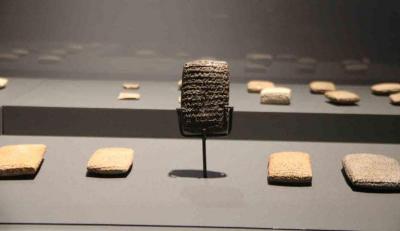 Kültepe - A 4,000-year-old tablet found in Kültepe shows that the first company in Anatolia was established by 12 people with 15 kilograms of gold. The excavations carried out in Kültepe Kaniş-Karum Ruins on the Kayseri-Sivas highway shed light on the commercial past of Anatolia. In the initial years of the 2nd millennium, the Assyrians founded multiple trading settlements in Anatolia. In archaeological terminology, the period of the Assyrian colonies, covering the first two centuries or so of the second millennium, is commonly known as the Middle Bronze Age. During this period, the Assyrians were very active in international trading and commercial ventures. The focal point of the merchant operations was the city of Nesa or Kanesh (Kültepe, also known as Kanesh or Nesha). Kültepe is considered one of the oldest trade centers of Anatolia and has a history of 6 thousand years. Excavations have been going on continuously for 75 years and more than 20 thousand cuneiform tablets have been found so far. These tablets reveal the commercial activities of the period in detail. Prof. Dr. Kulakoğlu states that most of the tablets in Kültepe were for commercial purposes and all kinds of financial transactions were recorded. Many details ranging from the expenditures of caravans to credit and debit relations are included in these tablets. This shows that Kültepe was a very active and large trade center at that time. Prof. Dr. Kulakoğlu stated that the information obtained from the tablets revealed that the first company established in Anatolia was established with a capital of 15 kilograms of gold and that this company had 12 partners. Each partner became a shareholder of the company by giving gold in different proportions. The capital of the company was managed by a merchant named Amur Ishtar for 12 years and one third of the profit was shared. All transactions related to the company were sealed and recorded in the presence of witnesses. Kulakoğlu said, “If you want to withdraw your share of the company’s capital before the due date, you will be given about 4 kilos of silver instead of 1 kilo of gold. If you withdraw your capital before its due date, you are making a loss. In other words, it is guaranteed that the capital will remain in place for a long period of 12 years.” “The tablets found here are dated to the period after the 1950s BC. This is the period when writing first started in Anatolia. Naturally, it is the first declaration of the first company in Anatolia, in a sense, a company deed. It appears here for the first time in Anatolia,” he said. Clay tablets do not only contain commercial information. Many social life details such as marriage contracts, divorces, inheritance documents, and notary procedures are also included in these tablets. This shows that Kültepe is a great source for us to understand the social and economic life of the period.
Kültepe - A 4,000-year-old tablet found in Kültepe shows that the first company in Anatolia was established by 12 people with 15 kilograms of gold. The excavations carried out in Kültepe Kaniş-Karum Ruins on the Kayseri-Sivas highway shed light on the commercial past of Anatolia. In the initial years of the 2nd millennium, the Assyrians founded multiple trading settlements in Anatolia. In archaeological terminology, the period of the Assyrian colonies, covering the first two centuries or so of the second millennium, is commonly known as the Middle Bronze Age. During this period, the Assyrians were very active in international trading and commercial ventures. The focal point of the merchant operations was the city of Nesa or Kanesh (Kültepe, also known as Kanesh or Nesha). Kültepe is considered one of the oldest trade centers of Anatolia and has a history of 6 thousand years. Excavations have been going on continuously for 75 years and more than 20 thousand cuneiform tablets have been found so far. These tablets reveal the commercial activities of the period in detail. Prof. Dr. Kulakoğlu states that most of the tablets in Kültepe were for commercial purposes and all kinds of financial transactions were recorded. Many details ranging from the expenditures of caravans to credit and debit relations are included in these tablets. This shows that Kültepe was a very active and large trade center at that time. Prof. Dr. Kulakoğlu stated that the information obtained from the tablets revealed that the first company established in Anatolia was established with a capital of 15 kilograms of gold and that this company had 12 partners. Each partner became a shareholder of the company by giving gold in different proportions. The capital of the company was managed by a merchant named Amur Ishtar for 12 years and one third of the profit was shared. All transactions related to the company were sealed and recorded in the presence of witnesses. Kulakoğlu said, “If you want to withdraw your share of the company’s capital before the due date, you will be given about 4 kilos of silver instead of 1 kilo of gold. If you withdraw your capital before its due date, you are making a loss. In other words, it is guaranteed that the capital will remain in place for a long period of 12 years.” “The tablets found here are dated to the period after the 1950s BC. This is the period when writing first started in Anatolia. Naturally, it is the first declaration of the first company in Anatolia, in a sense, a company deed. It appears here for the first time in Anatolia,” he said. Clay tablets do not only contain commercial information. Many social life details such as marriage contracts, divorces, inheritance documents, and notary procedures are also included in these tablets. This shows that Kültepe is a great source for us to understand the social and economic life of the period.
Anatolia's first company was founded 4000 years ago with 15 kilos of gold! - Arkeonews
SUISSE – 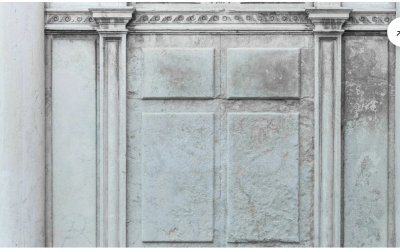 Cham-Oberwil - Excavation in a gravel quarry in central Switzerland revealed a 2,000-year-old Roman stone wall. The Roman site in the pre-alpine area could have been a villa or temple The Romans knew their way around Europe. They also knew how to build with a view. A 2,000-year-old stone wall unearthed in a gravel quarry in central Switzerland put those facts on display all over again, revealing an “archaeological sensation” that researchers hope will provide insights into the Romans as far north as Switzerland. The find, reported by the Canton of Zug’s Office for the Preservation of Monuments and Archeology, is more than just a wall. The wall itself—found just a few centimeters below the surface—encompasses at least 5,300 square feet near Cham-Oberwil and points to what was once an entire building complex with various rooms. Roman buildings of similar dimensions were last excavated in the area almost 100 years ago. “Only a few structural relics of this kind from the Roman period are known in the pre-Alpine region,” Christa Ebnöther, professor archeology of the Roman Provinces at the University of Bern, said in a translated statement. “What is also astounding is the relatively good preservation of the remains.” The elevated location near Äbnetwald offers a view of the surrounding landscape. It is unclear exactly what the function of the monumental building was, though possibilities include a grand villa with a lovely view or a temple. Large numbers of iron nails found at the site hint at wooden construction on the wall foundation. The experts found everyday items and more exclusive objects from Roman times, including tableware and artfully manufactured glass vessels. The fragments of amphorae, in which precious liquids such as wine, olive oil, and fish sauce were brought from the Mediterranean to Äbnetwald near Cham, show the extensive trade routes of Roman times. Additionally, the team also located gold fragments, probably originating from jewelry. Copper and bronze coins were also part of the discovery, including denarius featuring Julius Caesar from the 1st Century B.C. The researchers investigating the area hope that the find will provide important insights into the Romans in the pre-Alpine Central Switzerland. As they continue to search the area, they’ll always have that view.
Cham-Oberwil - Excavation in a gravel quarry in central Switzerland revealed a 2,000-year-old Roman stone wall. The Roman site in the pre-alpine area could have been a villa or temple The Romans knew their way around Europe. They also knew how to build with a view. A 2,000-year-old stone wall unearthed in a gravel quarry in central Switzerland put those facts on display all over again, revealing an “archaeological sensation” that researchers hope will provide insights into the Romans as far north as Switzerland. The find, reported by the Canton of Zug’s Office for the Preservation of Monuments and Archeology, is more than just a wall. The wall itself—found just a few centimeters below the surface—encompasses at least 5,300 square feet near Cham-Oberwil and points to what was once an entire building complex with various rooms. Roman buildings of similar dimensions were last excavated in the area almost 100 years ago. “Only a few structural relics of this kind from the Roman period are known in the pre-Alpine region,” Christa Ebnöther, professor archeology of the Roman Provinces at the University of Bern, said in a translated statement. “What is also astounding is the relatively good preservation of the remains.” The elevated location near Äbnetwald offers a view of the surrounding landscape. It is unclear exactly what the function of the monumental building was, though possibilities include a grand villa with a lovely view or a temple. Large numbers of iron nails found at the site hint at wooden construction on the wall foundation. The experts found everyday items and more exclusive objects from Roman times, including tableware and artfully manufactured glass vessels. The fragments of amphorae, in which precious liquids such as wine, olive oil, and fish sauce were brought from the Mediterranean to Äbnetwald near Cham, show the extensive trade routes of Roman times. Additionally, the team also located gold fragments, probably originating from jewelry. Copper and bronze coins were also part of the discovery, including denarius featuring Julius Caesar from the 1st Century B.C. The researchers investigating the area hope that the find will provide important insights into the Romans in the pre-Alpine Central Switzerland. As they continue to search the area, they’ll always have that view.
An Ancient Roman Wall Just Emerged in Switzerland. It's an Archaeological Sensation. (yahoo.com)